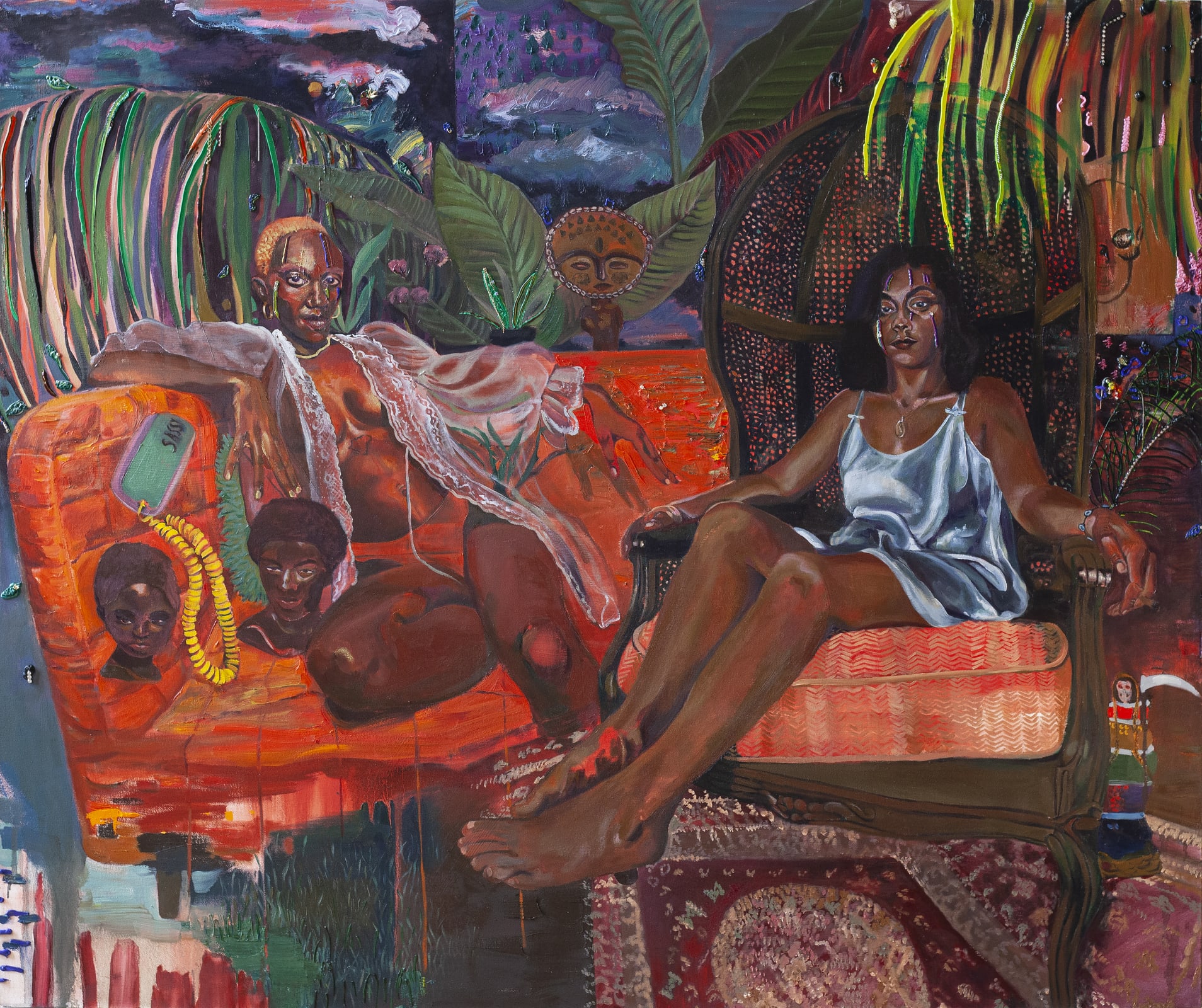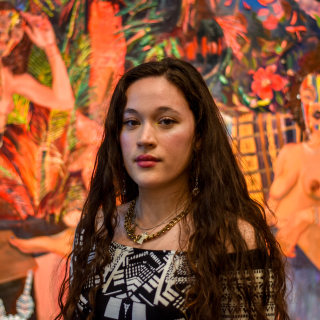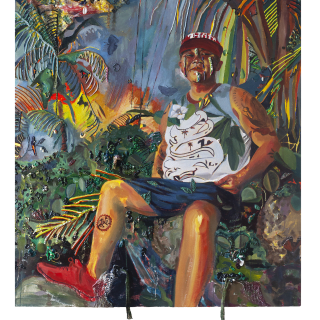Interview with Gisela McDaniel
Pilar Corrias: Could you talk us through the process of making a painting? From the initial concept to finalising the work.
Gisela McDaniel: I begin by finding subjects who are willing to share their story with me. This usually happens through word of mouth. I explain my process to the subjects, including how I started painting as a form of healing. I then conduct an interview with the subject in a space they are comfortable with, although more recently, I've started doing interviews over the internet due to the COVID-19 crisis. I photograph the subject immediately after the interview while their story is fresh in their minds.
I collage images keeping in mind what the subjects talked about. The collage will also include objects they mentioned or even brought with them to the interview. The next step is to prep my canvas, which is when I incorporate pieces of clothing or other fabric items provided by the subjects. I incorporate the fabrics onto the canvas working sculpturally on the surface before starting to paint. I then create a sketch from the collage and place it on the canvas. I add lush landscapes, paying attention to some details more than others. I then adorn the figures with recycled or broken jewellery gifted to me by the subject or as found objects.
The final step in completing the painting is the mask. What exists on the canvas before I paint the mask includes the intimate personal space I shared with the subject. Once the mask goes on, the painting is ready to be in the public gaze.
PC: Can you tell us a little bit more about the use of different kinds of media in your work? The inclusion of found and personal objects in your work seems to add another layer of lived experiences to your paintings.
GM: The objects I collect are things that have been previously worn on a body… I ask subjects to donate anything that they are no longer using, whether an earring that lost its pair or an old dress. These objects carry the spirit of the person that wore them which becomes part of the painting. I believe strongly that the things we wear represent small but telling decisions we make every day. They are part of the image we create for the world but they are also part of our daily armour. These items not only express but also absorb part of who we are, the smallest moments of our lives. In the end, that's what these portraits are about: the story of the woman depicted and the objects that capture intimate aspects of her life. Finally, I add pieces of broken jewellery that I source from recycling centres. The pieces are part of bulk broken jewellery that has been discarded but had a previous, unknown life. They are given new life when added to the portrait, creating another layer between the subject and the viewer.
PC: What are your main sources of inspiration in your practice?
GM: At the beginning, my inspiration was my own desire to heal. My process became more intricate as time went on. As I began interviewing other women, I wanted to document their strength and resilience. I've read that a big part of healing is the ability to talk about what happened. My goal became to honour their moments of triumph over trauma: moments of moving forward and carrying on. I wanted to preserve the stories of the women I interviewed and celebrate their strength as something hidden and precious that few of us are ever lucky enough to perceive. As survivors, we deal with the aftermath of events that remain with us for years and even lifetimes. By recording the stories of these women, I ensure that history hears their voices and recognises them as having saved themselves.
PC: Could you tell us more about your encounters with these women?
GM: Each painting represents my encounter with real persons. A lot of trust goes into these relationships, even if we were strangers from the start. The paintings are about solidarity. Not feeling alone in my experience and being heard was something I needed so badly, for so long. Being able to do that for other women is such an honour. It's like building an army.
There are so many things about society I'd like to see change. Using our voices, collectively, together, is powerful. It's my way of organising. I started this work a couple years before the 'Me Too' movement went 'viral'. I'd like to think at this point, most thoughtful people can agree this sexual violence happens everywhere, every day. I want to talk about it. I want others to HAVE to think about it, to consider it, to consider the experiences of the people you walk by everyday, especially those you don't really see or think about. Using audio is an immersive, unavoidable way to have people confront the humanity of these subjects. These images are about real stories, eyes that have wept and bodies that have survived violence. My hope is that viewers will, even for just one moment, stop and think about these stories, feel rage at the violence which our ancestors, our grandmothers, our mothers, our daughters, and our peers have lived through and are still experiencing.
I prioritise certain voices, specifically womxn of colour and especially, indigenous womxn who experience much higher rates of violence and murder. It is past time for them to not only be acknowledged, but to be treated with dignity, and respect. Most of all, I want people to acknowledge their strength.
PC: How is this ultimately translated into painting?
GM: The interviews are so intimate and personal, they stick with me. When I'm working, I feel like I am still with that person. I recall our time together, our conversation. By the nature of the exchange, the portraits capture a moment of release, of moving forward through and from trauma. When painting, the eye contact, masks and audio seals this into the canvas. To interact with the painting, you have to confront THEIR gaze, their voice. I create barriers between the viewer and the subject to further elevate the subject. The last barrier or layer I place between the subject and the viewer is the mask.
PC: What are you currently working on while at isolation?
GM: I am working on several different paintings. I work in spurts: interviewing, maintaining an archive of the images and audio I collect. Then I go down my list and often put women together who have never met but have similar experiences. Right now, I'm working on some portraits of Chamoru women I met in Guam. It was my first visit home to the island where mother and grandparents were born and where my ancestors come from. The landscape of the island was one I've felt connected to all my life, but had only just been imagining. After being there, where I was welcomed home by relatives I'd never met before and activists who were fighting to protect and decolonize the island, I am feeling more inspired than ever. There are so many exchanges I had with 'familian' and other Chamorus that I will remember forever. All of that is going into these works. I have also been dabbling with interviewing digitally while in quarantine, and am excited about how this will allow me to interview without restraints based on distance.
PC: What is keeping you sane during lockdown?
GM: I'm in a period where I'm focusing on producing work and doing interviews on the side, I'm able to immerse myself in that process. I've been reading, tuning into live DJ sets, and Face-timing with my family every day. I've also taken up roller blading.









